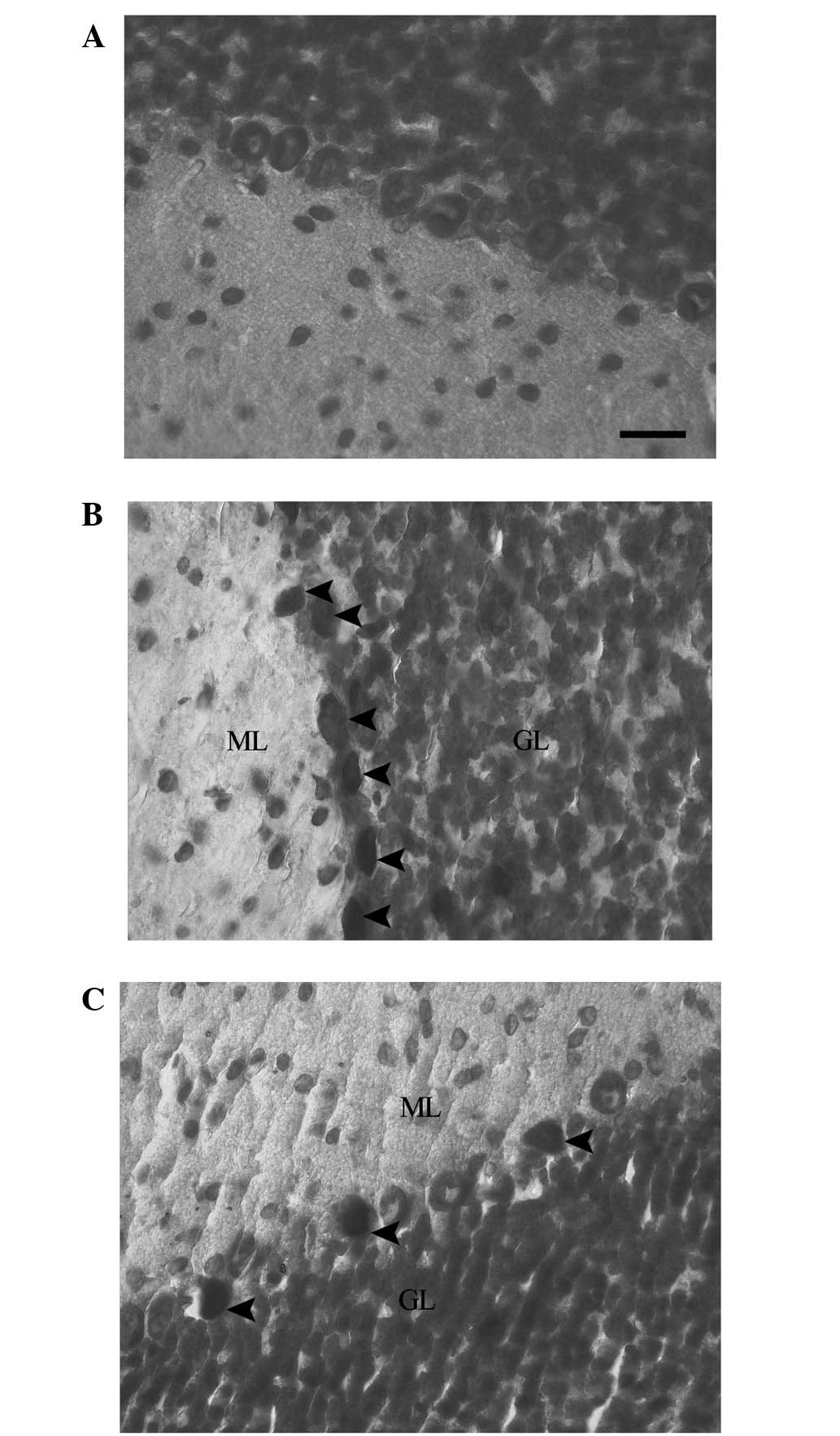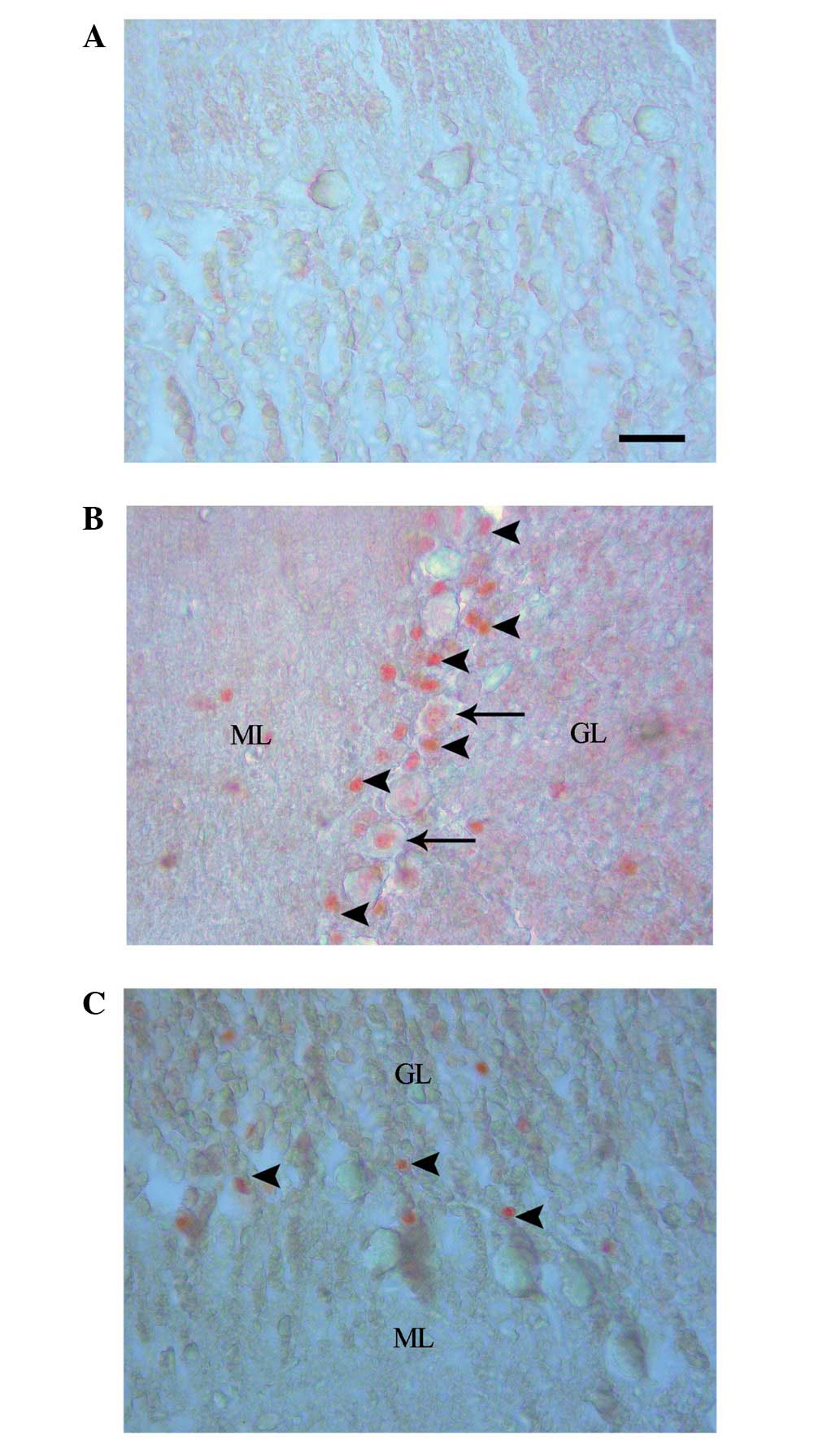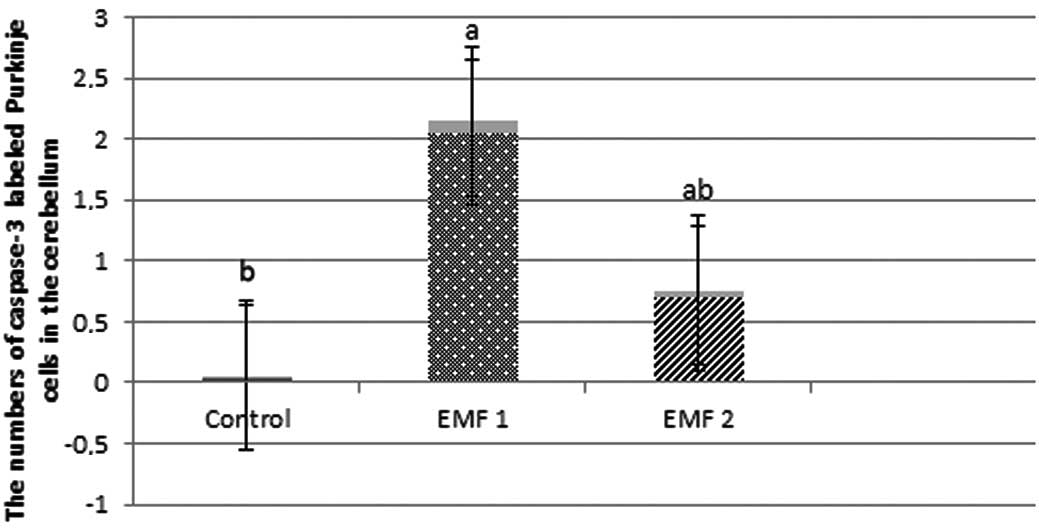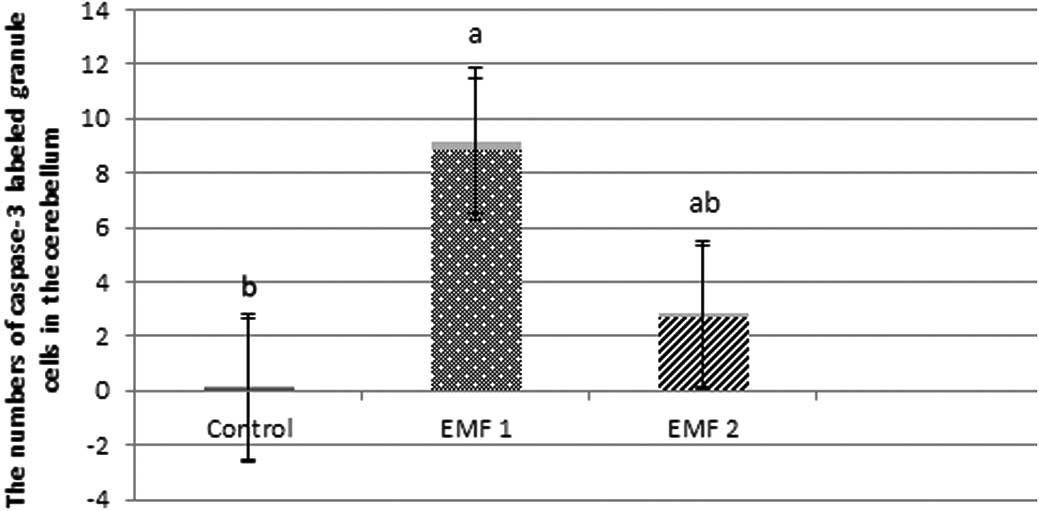|
1.
|
Akdag MZ, Dasdag S, Ulukaya E, Uzunlar AK,
Kurt MA and Taşkin A: Effects of extremely low-frequency magnetic
field on caspase activities and oxidative stress values in rat
brain. Biol Trace Elem Res. 138:238–249. 2010. View Article : Google Scholar : PubMed/NCBI
|
|
2.
|
Kim TH, Huang TQ, Jang JJ, et al: Local
exposure of 849 MHz and 1763 MHz radiofrequency radiation to mouse
heads does not induce cell death or cell proliferation in brain.
Exp Mol Med. 40:294–303. 2008. View Article : Google Scholar : PubMed/NCBI
|
|
3.
|
Joubert V, Leveque P, Cueille M,
Bourthoumieu S and Yardin C: No apoptosis is induced in rat
cortical neurons exposed to GSM phone fields. Bioelectromagnetics.
28:115–121. 2007. View Article : Google Scholar : PubMed/NCBI
|
|
4.
|
McNamee JP, Bellier PV, McLean JR, Marro
L, Gajda GB and Thansandote A: DNA damage and apoptosis in the
immature mouse cerebellum after acute exposure to a 1 mT, 60 Hz
magnetic field. Mutat Res. 513:121–133. 2002. View Article : Google Scholar : PubMed/NCBI
|
|
5.
|
Lai H and Singh NP: Magnetic-field-induced
DNA strand breaks in brain cells of the rat. Environ Health
Perspect. 112:687–694. 2004. View
Article : Google Scholar : PubMed/NCBI
|
|
6.
|
Grassi C, D’Ascenzo M, Torsello A,
Martinotti G, Wolf F, Cittadini A and Azzena GB: Effects of 50 Hz
electromagnetic fields on voltage-gated Ca2+ channels and their
role in modulation of neuroendocrine cell proliferation and death.
Cell Calcium. 35:307–315. 2004.
|
|
7.
|
Maskey D, Pradhan J, Aryal B, et al:
Chronic 835-MHz radio-frequency exposure to mice hippocampus alters
the distribution of calbindin and GFAP immunoreactivity. Brain Res.
1346:237–246. 2010. View Article : Google Scholar : PubMed/NCBI
|
|
8.
|
Sonmez OF, Odaci E, Bas O and Kaplan S:
Purkinje cell number decreases in the adult female rat cerebellum
following exposure to 900 MHz electromagnetic field. Brain Res.
1356:95–101. 2010. View Article : Google Scholar : PubMed/NCBI
|
|
9.
|
MacKenzie SH and Clark AC: Death by
caspase dimerization. Adv Exp Med Biol. 747:55–73. 2012. View Article : Google Scholar : PubMed/NCBI
|
|
10.
|
Wickman G, Julian L and Olson MF: How
apoptotic cells aid in the removal of their own cold dead bodies.
Cell Death Differ. 19:735–742. 2012. View Article : Google Scholar : PubMed/NCBI
|
|
11.
|
Folch J, Alvira D, López-Querol M, et al:
Evaluation of transcriptional activity of caspase-3 gene as a
marker of acute neurotoxicity in rat cerebellar granular cells.
Toxicol In Vitro. 24:465–471. 2010. View Article : Google Scholar : PubMed/NCBI
|
|
12.
|
Snigdha S, Smith ED, Prieto GA, et al:
Caspase-3 activation as a bifurcation point between plasticity and
cell death. Neurosci Bull. 28:14–24. 2012. View Article : Google Scholar : PubMed/NCBI
|
|
13.
|
Pace V, Bellizzi D, Giordano F, et al:
Experimental testing of a mathematical model relevant to the
extrinsic pathway of apoptosis. Cell Stress Chaperones. 15:13–23.
2010. View Article : Google Scholar : PubMed/NCBI
|
|
14.
|
Duran-Vilaregut J, Del Valle J, Manich G,
et al: Systemic administration of 3-nitropropionic acid points out
a different role for active caspase-3 in neurons and astrocytes.
Neurochem Int. 56:443–450. 2010. View Article : Google Scholar : PubMed/NCBI
|
|
15.
|
Hwang IK, Ahn JH, Yoo DY, et al: Increased
immunoreactivities of cleaved αII-spectrin and cleaved caspase-3 in
the aged dog spinal cord. Neurochem Res. 37:480–486. 2012.
|
|
16.
|
Liu J, Lu Y and Liang J: A novel
fluorescence derivatization method combined with HPLC for
determining the activities of endogenous caspase. Analyst.
137:5097–5104. 2012. View Article : Google Scholar : PubMed/NCBI
|
|
17.
|
Hossmann KA: Effects of electromagnetic
radiation of mobile phones on the central nervous system.
Bioelectromagnetics. 24:49–62. 2003. View Article : Google Scholar : PubMed/NCBI
|
|
18.
|
The sensitivity of children to EMF
exposure. In: Proceedings of the 2004 EPRI-Cosponsored World Health
Organization Workshop; EPRI, Palo Alto, NC, USA. 1011147(3): pp.
3–13. 2004
|
|
19.
|
Rodier PM: Chronology of neuron
development: animal studies and their clinical implications. Dev
Med Child Neurol. 22:525–545. 1980. View Article : Google Scholar : PubMed/NCBI
|
|
20.
|
Bas O, Odaci E, Kaplan S, et al: 900 MHz
electromagnetic field exposure affects qualitative and quantitative
features of hippocampal pyramidal cells in the adult female rat.
Brain Res. 1265:178–185. 2009. View Article : Google Scholar : PubMed/NCBI
|
|
21.
|
Giovannucci E: Tomato products, lycopene,
and prostate cancer: a review of the epidemiological literature. J
Nutr. 135:2030S–2031S. 2005.PubMed/NCBI
|
|
22.
|
Ford NA, Elsen AC, Zuniga K, Lindshield BL
and Erdman JW Jr: Lycopene and apo-12′-lycopenal reduce cell
proliferation and alter cell cycle progression in human prostate
cancer cells. Nutr Cancer. 63:256–263. 2011.PubMed/NCBI
|
|
23.
|
Teodoro AJ, Oliveira FL, Martins NB, Maia
Gde A, Martucci RB and Borojevic R: Effect of lycopene on cell
viability and cell cycle progression in human cancer cell lines.
Cancer Cell Int. 12:362012. View Article : Google Scholar : PubMed/NCBI
|
|
24.
|
Rissanen TH, Voutilainen S, Nyyssönen K,
Salonen R, Kaplan GA and Salonen JT: Serum lycopene concentrations
and carotid atherosclerosis: the Kuopio Ischaemic Heart Disease
Risk Factor Study. Am J Clin Nutr. 77:133–138. 2003.PubMed/NCBI
|
|
25.
|
Coyne T, Ibiebele TI, Baade PD, Dobson A,
McClintock C, Dunn S, et al: Diabetes mellitus and serum
carotenoids: findings of a population-based study in Queensland,
Australia. Am J Clin Nutr. 82:685–693. 2005.PubMed/NCBI
|
|
26.
|
Agca CA, Tuzcu M, Gencoglu H, Akdemir F,
Ali S, Sahin K and Kucuk O: Lycopene counteracts the hepatic
response to 7,12-dimethylbenz[a]anthracene by altering the
expression of Bax, Bcl-2, caspases, and oxidative stress
biomarkers. Pharm Biol. 50:1513–1518. 2012.PubMed/NCBI
|
|
27.
|
Kelkel M, Schumacher M and Dicato M:
Antioxidant and anti-proliferative properties of lycopene. Free
Radic Res. 45:925–940. 2011. View Article : Google Scholar : PubMed/NCBI
|
|
28.
|
Kong KW, Rajab NF, Prasad KN, Ismail A,
Markom M and Tan CP: Lycopene-rich fractions derived from pink
guava by-product and their potential activity towards hydrogen
peroxide-induced cellular and DNA damage. Food Chem. 123:1142–1148.
2010. View Article : Google Scholar
|
|
29.
|
Khachik F, Carvalho L, Bernstein PS, Muir
GJ, Zhao DY and Katz NB: Chemistry, distribution, and metabolism of
tomato carotenoids and their impact on human health. Exp Biol Med
(Maywood). 227:845–851. 2002.PubMed/NCBI
|
|
30.
|
Qu M, Zhou Z, Chen C, et al: Lycopene
protects against trimethyltin-induced neurotoxicity in primary
cultured rat hippocampal neurons by inhibiting the mitochondrial
apoptotic pathway. Neurochem Int. 59:1095–1103. 2011. View Article : Google Scholar : PubMed/NCBI
|
|
31.
|
Maeda K, Maeda T and Qi Y: In vitro
and in vivo induction of human LoVo cells into apoptotic
process by non-invasive microwave treatment: A potentially novel
approach for physical therapy of human colorectal cancer. Oncol
Rep. 11:771–775. 2004.
|
|
32.
|
Caraglia M, Marra M, Mancinelli F, et al:
Electromagnetic fields at mobile phone frequency induce apoptosis
and inactivation of the multi-chaperone complex in human epidermoid
cancer cells. J Cell Physiol. 204:539–548. 2005. View Article : Google Scholar
|
|
33.
|
Capri M, Scarcella E, Bianchi E, et al:
1800 MHz radiofrequency (mobile phones, different Global System for
Mobile communication modulations) does not affect apoptosis and
heat shock protein 70 level in peripheral blood mononuclear cells
from young and old donors. Int J Radiat Biol. 80:389–397. 2004.
View Article : Google Scholar
|
|
34.
|
Capri M, Scarcella E, Fumelli C, et al: In
vitro exposure of human lymphocytes to 900 MHz CW and GSM modulated
radio-frequency: studies of proliferation, apoptosis and
mitochondrial membrane potential. Radiat Res. 162:211–218. 2004.
View Article : Google Scholar
|
|
35.
|
Aydın S, Tokaç M, Taner G, et al:
Antioxidant and antigenotoxic effects of lycopene in obstructive
jaundice. J Surg Res. Nov 7–2012.(Epub ahead of print). View Article : Google Scholar
|
|
36.
|
Saada HN, Rezk RG and Eltahawy NA:
Lycopene protects the structure of the small intestine against
gamma-radiation-induced oxidative stress. Phytother Res. 24(Suppl
2): S204–S208. 2010. View
Article : Google Scholar : PubMed/NCBI
|
|
37.
|
Tang Y, Parmakhtiar B, Simoneau AR, Xie J,
Fruehauf J, Lilly M and Zi X: Lycopene enhances docetaxel’s effect
in castration-resistant prostate cancer associated with
insulin-like growth factor I receptor levels. Neoplasia.
13:108–119. 2011.PubMed/NCBI
|
|
38.
|
Gervais FG, Xu D, Robertson GS, et al:
Involvement of caspases in proteolytic cleavage of Alzheimer’s
amyloid-beta precursor protein and amyloidogenic A beta peptide
formation. Cell. 97:395–406. 1999.
|
|
39.
|
Türk G, Ceribaşi AO, Sakin F, Sönmez M and
Ateşşahin A: Antiperoxidative and anti-apoptotic effects of
lycopene and ellagic acid on cyclophosphamide-induced testicular
lipid peroxidation and apoptosis. Reprod Fertil Dev. 22:587–596.
2010.PubMed/NCBI
|


















